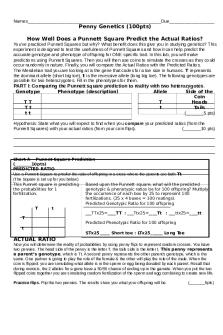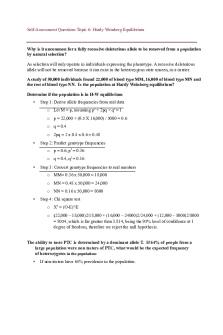Genetics - Stern Cardinale PDF

| Title | Genetics - Stern Cardinale |
|---|---|
| Author | Kirsten Orr |
| Course | General Biology I |
| Institution | Rutgers University |
| Pages | 5 |
| File Size | 109.7 KB |
| File Type | |
| Total Downloads | 75 |
| Total Views | 150 |
Summary
Stern Cardinale...
Description
Genetics During I.
Gregar Mendel and His Experiments → SEQ Mendel’s work → CC competing hypotheses → CC principles of heredity
II.
Genetic Crosses → SEQ, CC, APPLY genetic crosses
III.
Using Probability in Genetics → APPLY probability rules
-
Gene: a unit of heredity Allele: an alternative version of a gene Character: observable feature (i.e. hair color) Trait: all possible characters (i.e. blonde, red, etc.) Genotype: what alleles are present Phenotype: physical presence of genes Gene → character → hair color Alleles → traits → red hair
I.
Gregar Mendel A. Background 1. Austrian monk 2. Figured basic rules of inheritance for eukaryotes (diploid eukaryotes)
3. Experimental Organism: Garden Pea Plant • Lots of identifiers • Easy to grow • Very short generation time • Easy to control population • 3u strains of plant • Used quantitative method → scientific process • Recorded data (not done before Mendel) • Developed true-breeding line • True breeding → always express the same trait • After self replication → homozygous → all express the same phenotype • 2 years of true breeding before crossing B. Testing “Blending Inheritance” 1. Blending hypothesis 2. Gametes contain sampling or fluids from parents’ bodies 3. Fuse during reproduction 4. Fluids blend, offspring is intermediate •
Experimental Crosses with D-Generation ◦ Parents breed → F 1 (first offspring) → F 2 (grandkids)
•
Prediction: ◦ White + Red → Pink ◦ Mendel: Purple + White → P1 ◦ Observation F 1 resembles one parent ◦ F 2 is a mix of both parents (3:1 ratio) ◦ Extremely consistent for experiments
•
Conclusion: ◦ No intermediate mix ◦ Blending hypotheses not true
C. Mendel’s Model -
Particulate Inheritance: alternative hypothesis Heritable Factors: genes Each character controlled by 2 factors — 1 each
-
4 Components: 1. Alleles: alternative version of a gene 2. 2 factors for each character → diploid a) In true breeding, lines can be identical b) Found on homologous chromosomes 3. Dominance a) Dominant → affects phenotype i) Dominant = P b) Recessive → hidden in phenotype i) Recessive = p 4. Principles of Heredity a) Laws of Segregation: the idea that the 2 alleles separate during gamete formation → haploid b) Laws of Independent Assortment: genes on different chromosomes sort independently during gamete formation c) Random orientation of tetrads during metaphase I d) Results in genetic recombination → new combination of alleles in offspring e) 2nd mechanism increases genetic variation
II.
Genetic Crosses A. Introduction -
Follow allele behavior to predict offspring Allows use to make and test predictions Determine gametes of parents Figure out possible genotypes for offspring Calculate the frequencies
B. Monohybrid (one mix cross) -
Cross between heterozygotes P1 Generation → Homozygous D + Homozygous R ↓ F1: Heterozygous: 100% = Yy
C. Monohybrid Test Cross
III.
Using Probability to Determine Outcomes A. Intro to Probability in Genetics B. Multiplication Rule 1. Find the probability of independent events
* Multiply probabilities of independent events 0.5 × 0.5 = 0.25 C. Addition Rule 1. Predicts combined probability of mutually exclusive events 2. Mutually Exclusive Events: cannot happen together P1 or P2 separate possibilities Mom: Aa Dad: Aa
0.25 + 0.25 = 0.50...
Similar Free PDFs

Genetics - Stern Cardinale
- 5 Pages

Daniel Stern
- 1 Pages

Expresion- Arno Stern
- 103 Pages

8 - Travis Stern
- 2 Pages

Daniel Stern Appunti
- 4 Pages

Stern mba admission viewbook
- 24 Pages

Genetics Penny Genetics
- 4 Pages

Stern Dreieck Umschaltung
- 1 Pages

1 - Travis Stern
- 3 Pages

Genetics questionse
- 10 Pages

2.3,5 - Genetics
- 13 Pages

Genetics objectives
- 26 Pages

Mouse Genetics
- 5 Pages

Human Genetics
- 500 Pages

Genetics Tutorial
- 5 Pages
Popular Institutions
- Tinajero National High School - Annex
- Politeknik Caltex Riau
- Yokohama City University
- SGT University
- University of Al-Qadisiyah
- Divine Word College of Vigan
- Techniek College Rotterdam
- Universidade de Santiago
- Universiti Teknologi MARA Cawangan Johor Kampus Pasir Gudang
- Poltekkes Kemenkes Yogyakarta
- Baguio City National High School
- Colegio san marcos
- preparatoria uno
- Centro de Bachillerato Tecnológico Industrial y de Servicios No. 107
- Dalian Maritime University
- Quang Trung Secondary School
- Colegio Tecnológico en Informática
- Corporación Regional de Educación Superior
- Grupo CEDVA
- Dar Al Uloom University
- Centro de Estudios Preuniversitarios de la Universidad Nacional de Ingeniería
- 上智大学
- Aakash International School, Nuna Majara
- San Felipe Neri Catholic School
- Kang Chiao International School - New Taipei City
- Misamis Occidental National High School
- Institución Educativa Escuela Normal Juan Ladrilleros
- Kolehiyo ng Pantukan
- Batanes State College
- Instituto Continental
- Sekolah Menengah Kejuruan Kesehatan Kaltara (Tarakan)
- Colegio de La Inmaculada Concepcion - Cebu
